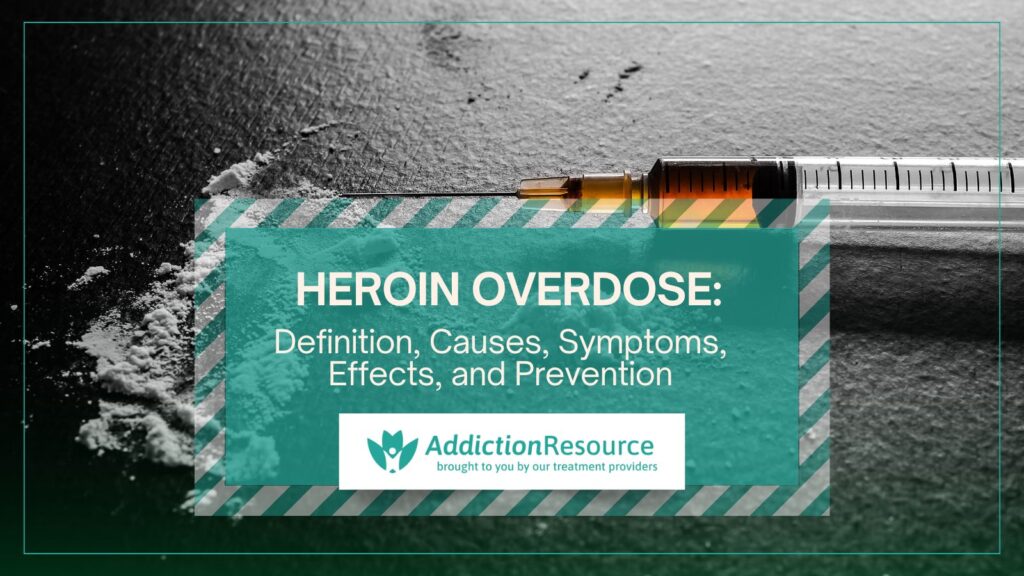
A heroin overdose occurs when an individual consumes a toxic or excessive amount of heroin which leads to a high risk of life-threatening symptoms and organ failure. The main causes of heroin overdose are using a higher dose than the body can tolerate, mixing heroin with other substances like alcohol or sedatives, and using heroin again after taking a break or when your body is no longer used to it.
Heroin is a powerful pain relief drug made from morphine. Heroin is highly addictive and causes severe withdrawal symptoms. Heroin has been illegal in the United States since 1924 and belongs to a group of drugs called opioids. The main symptoms of heroin overdose are slow breathing, pinpoint pupils, loss of consciousness, cyanosis, and weak pulse. The main effects include respiratory depression, brain damage due to hypoxia, cardiac arrest, coma, or death.
Table Of Contents:
- What is Heroin Overdose?
- What are the Causes of Heroin Overdose?
- What are the Symptoms of Heroin Overdose?
- What are the Side Effects of Heroin Overdose?
- What are the Emergency Response Steps for Heroin Overdose?
- What are the Treatment Options for Heroin Overdose?
- How to Prevent a Heroin Overdose?
- What is Heroin?

What is Heroin Overdose?
A heroin overdose occurs when excessive amounts of the drug overwhelm the body’s systems, leading to critical respiratory depression and potential death. According to the National Institute on Drug Abuse (NIDA), in 2021, approximately 9,173 people died from an overdose involving heroin in the United States. This public health crisis has seen fluctuations in death rates, with a notable decline attributed to changing drug use patterns and the increasing prevalence of fentanyl.
According to Spencer, M. R.’s March 2024, ‘Drug overdose deaths in the United States, 2002–2022 (NCHS Data Brief No. 491). report’, while heroin overdose deaths declined by 35.7% (from 2.8 to 1.8 per 100,000) between 2021-2022, deaths involving synthetic opioids like fentanyl increased by 4.1% (from 21.8 to 22.7 per 100,000), demonstrating a dramatic shift in the opioid crisis landscape with synthetic opioids now causing more than 12 times as many deaths as heroin.
Causes of heroin addiction are dependence, high tolerance, consumption of high doses, usage of other substances, and decreased tolerance after taking a break.
The main symptoms of heroin addiction are breathing problems, dry mouth, extremely small pupils, discolored tongue, low blood pressure, weak pulse, cyanosis, constipation, and spasms of the stomach and intestines.
The main side effects of heroin overdose are coma, permanent brain damage, organ damage, respiratory arrest, and cardiovascular collapse.
The main strategies for preventing a heroin overdose are avoiding heroin, visiting safe injection sites, keeping naloxone available, educating oneself about heroin potency, and raising community awareness about risks and safe practices.
What are the Causes of Heroin Overdose?
The causes of heroin overdose include dependence, high tolerance, taking high doses, usage with other substances, and decreased tolerance after taking a break.
The 5 main causes of heroin overdose are listed below.
- Dependence: Chronic use of heroin leads to physical and psychological dependence. The complete dependence compels the individuals to consume the drug regularly to avoid withdrawal symptoms. It drives users to take higher doses, increasing the risk of overdose, according to a journal published by Jennifer C. Veilleux in 2019 titled “A review of opioid dependence treatment: Pharmacological and psychosocial interventions to treat opioid addiction.”
- High Tolerance: Regular heroin users develop a tolerance and require larger amounts to achieve the desired effect. The increase in dosage enhances the risk of overdose as the margin between an effective dose and a lethal dose narrows.
- Consumption of High Doses: Ingesting large quantities of heroin overwhelms the ability of the human body to process heroin and leads to toxic effects such as respiratory depression, coma, or death. The risk is high when users misjudge their tolerance or the potency of the drug.
- Usage of Heroin with Other Drugs: Mixing heroin with other depressants like alcohol, benzodiazepines, or barbiturates increases its effects and the chances of overdose. These combinations lead to severe respiratory depression and other life-threatening complications, according to a research article published by Phillips JK in 2017 titled “Trends in Opioid Use, Harms, and Treatment.”
- Decreased Tolerance After Break: The person’s body becomes less used to heroin after taking a break. Taking the same amount as before saturates the body and leads to an overdose.
What are the Symptoms of Heroin Overdose?
The symptoms of a heroin overdose include breathing problems, dry mouth, extremely small pupils, discolored tongue, low blood pressure, weak pulse, cyanosis, constipation, and spasms of the stomach and intestines.
The 9 main symptoms of heroin overdose are written below.
- Breathing Problems: Heroin overdose leads to a variety of severe symptoms that result from its depressant effects on the central nervous system. One of the most dangerous effects is breathing problems. Heroin depresses respiration and causes slow or shallow breathing. Respiratory depression leads to insufficient oxygen supply to vital organs and causes brain damage or death, according to a research article published by Rob Hill in 2019 titled “Fentanyl depression of respiration: Comparison with heroin and morphine.”
- Dry Mouth: Dry mouth is another common symptom of heroin overdose. Heroin reduces saliva production, which results in dry mouth. The symptoms are less severe but contribute to dental issues and discomfort in heroin-addicted people.
- Extremely Small Pupils: Heroin overdose also leads to extremely small pupils, a condition known as miosis. Extremely small pupils (miosis) occur due to the action of heroin on the parasympathetic nervous system and cause excessive constriction of the pupils. Miosis is the main symptom of a heroin overdose in heroin-addicted individuals.
- Discolored Tongue: Heroin suppresses breathing, depriving the body of oxygen, which results in hypoxia. The lack of oxygen causes discoloration of the tongue, with a bluish or purplish tint as an indicator of oxygen deprivation.
- Low Blood Pressure: Low blood pressure, or hypotension, is another common symptom of heroin overdose. Heroin causes vasodilation, which leads to a drop in blood pressure. Hypotension (low blood pressure) results in dizziness, fainting, and, in severe cases, shock, according to a 2006 book by Rockville titled “4 Physical Detoxification Services for Withdrawal From Specific Substances.”
- Weak Pulse: Heroin’s effect on the cardiovascular system also results in a weak or slow pulse. A weak pulse decreases blood flow and oxygen to vital organs, causing damage.
- Cyanosis: Heroin overdose also causes cyanosis. Cyanosis is a condition where the skin, lips, or nails turn a bluish color due to a lack of oxygen in the blood. Heroin overdose causes cyanosis, which is a direct consequence of respiratory depression.
- Constipation: Heroin slows gastrointestinal motility and leads to constipation (infrequent bowel movements). Heroin use causes constipation, but severe cases during an overdose lead to discomfort and complications.
- Spasms of the Stomach and Intestines: Heroin affects the digestive system, causing abdominal cramps and spasms. If not treated, they lead to discomfort and a high risk of complications, including lack of blood flow to the intestines.
What are the Side Effects of Heroin Overdose?
The side effects of a heroin overdose include coma, permanent brain damage, and organ failure.
These heroin side effects are listed below.
- Coma: Heroin overdose leads to some of the most severe and life-threatening consequences due to its depressant effects on the central nervous system. Coma is one of the most serious side effects of a heroin overdose. Coma is a state of prolonged unconsciousness where the individual cannot awake and fails to respond to stimuli. Heroin overdose depresses the central nervous system to the point of inducing a coma. Coma requires immediate medical intervention to prevent fatal outcomes.
- Permanent Brain Damage: Another serious side effect of a heroin overdose is permanent brain damage. Heroin overdose causes severe respiratory depression and leads to hypoxia (deficiency in oxygen reaching the brain). Prolonged hypoxia results in irreversible brain damage, affecting cognitive functions, motor skills, and overall quality of life.
- Organ Damage: The lack of oxygen and reduced blood flow during a heroin overdose cause damage to vital organs such as the heart, liver, and kidneys. The damage leads to long-term health risks, including heart failure, liver disease, and renal failure. These complications are due to the systemic effects of heroin overdose. The same underlying causes of respiratory depression and hypoxia affect multiple organs.
- Respiratory Arrest: Respiratory arrest is one of the most critical life-threatening conditions caused by heroin overdose. Respiratory arrest is a life-threatening condition where the lungs no longer take in oxygen or remove carbon dioxide. A heroin overdose causes breathing to slow or stop entirely, which leads to respiratory arrest.
- Cardiovascular Collapse: Cardiovascular collapse is another severe outcome of heroin overdose. Heroin overdose causes a drop in blood pressure and heart rate and leads to cardiovascular collapse. It affects the ability of the heart to pump the blood effectively and causes cardiac arrest, according to a research article published by Acad Emerg in 2013 titled “Incidence of Adverse Cardiovascular Events in Adults Following Drug Overdose.”
What are the Emergency Response Steps for Heroin Overdose?
The emergency response steps for a heroin overdose include attempting to wake the person, administering CPR, and giving naloxone.
These emergency response steps are written below.
- Step #1 Attempt to Wake the Person: Gently shake the individual and call their name loudly to monitor responsiveness. If they do not respond, apply a firm sternum rub (rubbing knuckles firmly on the center of the chest) to check the reaction. Lack of response means there is a need for immediate medical intervention.
- Step #2 Administer CPR: If the person is not breathing or has a weak pulse, begin cardiopulmonary resuscitation (CPR). Perform chest compressions at a rate of 100-120 per minute, pressing down hard and fast in the center of the chest. Provide rescue breaths after every 30 compressions. Continue until emergency medical services arrive or the person shows signs of recovery.
- Step #3 Administer Naloxone: Naloxone is a medication that rapidly reverses the effects of opioid overdose by displacing opioids from their receptors in the brain and restoring normal respiration. Naloxone is administered via nasal spray or injection. Naloxone is available without a prescription at pharmacies in many regions, according to a research article taken from the Centers for Disease Control and Prevention titled “Reverse Opioid Overdose to Prevent Death.”
What are the Treatment Options for Heroin Overdose?
The treatment options for heroin overdose include emergency intravenous interventions, administration of medications, detoxification, rehabilitation programs, and participation in support groups.
The 5 best treatment options for heroin overdose are listed below.
- Emergency Intravenous (IV) Interventions: Emergency IV interventions are an important part of the treatment plan for heroin overdose. The treatment involves administering fluids and medications directly into the bloodstream to check vital signs, correct electrolyte imbalances, and support organ function. The hospital provides acute care in case of heroin overdose, which lasts until the patient recovers within 24 to 48 hours.
- Administration of Medications: Medications play an important role in both the immediate reversal of overdose effects and the long-term treatment of heroin addiction. Naloxone is an opioid antagonist used to rapidly reverse the effects of heroin overdose by displacing opioids from their receptors. Naloxone restores normal respiration and reduces the withdrawal symptoms. The duration of medication ranges from several months to years.
- Detoxification: Detoxification is a critical first step in the treatment of heroin addiction. It focuses on allowing the body to eliminate the drug while managing withdrawal symptoms. The detox process is carried out in either inpatient or outpatient settings, lasting from a few days to a week, depending on the individual’s level of dependence and overall health. Monitoring is necessary to ensure safety and comfort during withdrawal.
- Rehabilitation Programs: Rehabilitation programs provide treatment plans that include counseling, behavioral therapies, and education to address the psychological aspects of addiction. These programs are inpatient (residential) or outpatient and last from 30 days to several months.
- Support Groups: Support groups play an important role in the recovery process by offering peer support and the opportunity to share experiences. Support groups are valuable in helping individuals maintain discipline. Participation in these groups is ongoing and consistent in recovery and provides a sense of accountability.
How to Prevent a Heroin Overdose?
To prevent a heroin overdose, you should practice harm reduction techniques by avoiding heroin, visiting safe injection sites, and keeping naloxone available. Educate yourself about the potency of heroin and avoid mixing it with other substances like alcohol. Community awareness and education about risks and safe practices are important in reducing the chances of heroin overdose.
What is Heroin?
Heroin is a highly addictive opioid drug made from morphine. Heroin is a natural substance extracted from the seed pods of certain poppy plants. It is classified as a depressant, which slows down brain function and activity of the central nervous system. Users inject, snort, or smoke heroin, which appears in white or brown powder form or as a sticky black substance known as “black tar.”
Why is Heroin Harmful?
Heroin is harmful because it is highly addictive and affects the brain and body. Heroin depresses the central nervous system, slowing breathing and heart rate, which leads to overdose or death. Chronic use damages vital organs, including the liver, kidneys, and lungs, and causes infections at injection sites.
Can Heroin Addiction Lead to Overdose?
Yes, heroin addiction increases the risk of overdose. Users with heroin addiction develop tolerance, which forces them to consume larger amounts of heroin to achieve the same effects, pushing the dose closer to a lethal level.
How Do People Consume Heroin?
Heroin is consumed in several ways, including injecting, snorting, or smoking. The injection delivers heroin directly into the bloodstream and produces a rapid and intense effect, but also increases the risk of overdose. Snorting and smoking provide slower absorption but are equally harmful over time.
Can You Overdose on Pure Heroin?
Yes, overdosing on pure heroin is possible because users underestimate its potency. Pure heroin delivers a stronger and more immediate effect, which quickly saturates the body and leads to respiratory depression or death.
Can a Heroin Overdose Be Reversed?
Yes, a heroin overdose can be reversed with the timely administration of naloxone. Naloxone is an opioid antagonist that rapidly blocks the effects of heroin on the brain. It restores normal breathing and consciousness when given timely.
Can Heroin Overdose Cause Permanent Damage to the Brain and Body?
Yes, a heroin overdose causes permanent damage to the brain and body due to prolonged depletion of oxygen (hypoxia). Hypoxia leads to cognitive impairments, memory loss, and loss of motor skills.
Is Naloxone the Only Medication to Treat Heroin Overdose?
No, naloxone is the most effective medication for reversing heroin overdose, but it is not the only treatment. Oxygen therapy, IV fluids, and other medications are used in hospitals to stabilize the patient.
How does heroin overdose differ from other opioid overdoses?
Heroin overdose differs from other opioid overdoses by its rapid onset and short duration compared to fentanyl and methadone. Fentanyl is far more potent, and mixed with other drugs increases the risk of overdose. Methadone overdoses happen slowly but last longer because it stays in the body for a long time.
Are Heroin Withdrawal Symptoms Worse Than Methadone Withdrawal Symptoms After an Overdose?
Yes, heroin withdrawal symptoms are more intense but shorter in duration compared to methadone. Heroin withdrawal begins within a few hours of the last use and peaks within 24-48 hours. It has symptoms like severe cravings, nausea, muscle pain, and agitation. The duration of Methadone withdrawal lasts much longer due to its long half-life.
Are the Signs of Fentanyl and Heroin Overdose the Same?
No, fentanyl overdose is more severe and rapid due to its extreme potency. Both fentanyl and heroin overdoses share signs like respiratory depression, unconsciousness, and pinpoint pupils. However, fentanyl causes overdose more quickly and requires multiple doses of naloxone for reversal due to its stronger binding to the opioid receptors.
How long does heroin stay in the system?
Heroin stays in the system for approximately 7.6 to 21.8 minutes due to its short half-life. Heroin stays in the system as metabolites, which remain detectable for extended periods. In the liver, heroin converts to morphine and 6-MAM, traceable for 24 to 72 hours. Detection windows depend on factors like usage frequency, dosage, metabolism, hydration, body fat, heroin purity, and consumption volume.
Find Drug Rehabilitation Centers Near You Anywhere In the US
Addiction Resource team has compiled an extensive list of the top drug rehabilitation facilities around the country. Use our locator tool to find the best centers near you.


 Reviewed by:
Reviewed by: 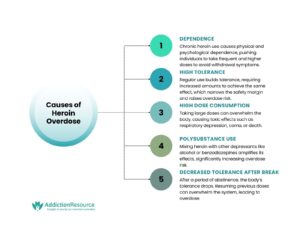
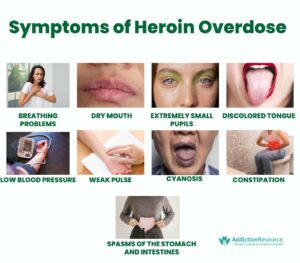
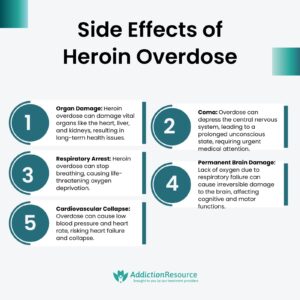
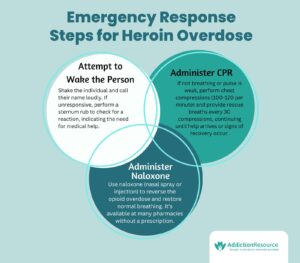
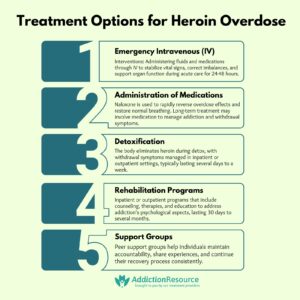

 FindTreatment.gov
FindTreatment.gov